Case Study: Media Representations of Women's Bodies in Modern Society
VerifiedAdded on 2022/09/29
|10
|3452
|23
Case Study
AI Summary
This case study analyzes the media's representation of women's bodies, focusing on its impact on body image and societal perceptions. It explores the evolution of the term 'body image,' distinguishing between body perception and body satisfaction, and highlights how media portrayals often promote unrealistic beauty standards. The study delves into the social comparison theory, explaining how exposure to media influences body dissatisfaction, particularly among women. It examines the consequences of these representations, including potential links to eating disorders, declining self-esteem, and depression. Furthermore, the case study references various research studies and findings to support its arguments, including the impact of media on young girls and the influence of television programs on body image perceptions. The assignment also touches upon the role of advertisers in using specific models and the overall effect of sexualizing media. The study concludes by emphasizing the need for critical awareness of media's impact on body image and the adoption of policies to address these negative effects.

Module Code: LC663
Module Title: Body, Culture, and Society
Assignment No. and Type: CW2 Case Study
Media Representations of Women’s and/or Men’s Bodies
Student ID: 21807664
Module Title: Body, Culture, and Society
Assignment No. and Type: CW2 Case Study
Media Representations of Women’s and/or Men’s Bodies
Student ID: 21807664
Paraphrase This Document
Need a fresh take? Get an instant paraphrase of this document with our AI Paraphraser

P a g e | 2
Introduction
This case study is on media representation of women’s body. Media representation
on male or female body is one of the areas that has received significant interest from
the researchers. This research area has mainly explored the impact of images of
attractive and thin females, or males with distinctly developed muscles, on those
view them (Burrowes, 2013). Additionally, in recent years, there is an increasing
awareness among parents, mental healthcare professionals, child advocates
regarding the influence of mass media and the impact of advertising and media
consumption on the body image of people (House of Commons Women and
Equalities Committee, 2021). Previously, it was viewed that negative body image is
normally perceived as a problem of young females, but research has demonstrated
that the consequences of body image on media are broader issues (House of
Commons Women and Equalities Committee, 2021). For example, the House of
Commons Women and Equalities Committee (2021) has noted that more than 33%
of adult individuals demonstrated their anxiousness or depression regarding their
body image, and approximately half of them wanted to see more diversities in the
mainstream media. Similarly, cited in the House of Commons Women and Equalities
Committee (2021), a study conducted by the UK’s National Health Service (NHS)
demonstrated that nearly 60% of young adults expressed that they experienced
pressure on the social media for looking good, and nearly one-fourth of them opined
that they should have a perfect male body. Another study carried out by the Mental
Health Foundation, cited in the House of Commons Women and Equalities
Committee (2021), found that nearly half (44%) of the LGBT (Lesbian, Gay,
Bisexual, and Transgender) adults experienced shame due to their body image.
Furthermore, a survey conducted by Trailblazers, cited in the House of Commons
Women and Equalities Committee (2021), demonstrated that 80% of the disabled
individuals opined that their body images directly affect their mental wellbeing. All the
outcomes of these studies suggest that body image has a significant impact on
people, and thus it is necessary to assess the causes of poor body image, how it
affects individuals through mass media, and what policies the government can adopt
to tackle the negative effect of body image through mass media on individuals.
Introduction
This case study is on media representation of women’s body. Media representation
on male or female body is one of the areas that has received significant interest from
the researchers. This research area has mainly explored the impact of images of
attractive and thin females, or males with distinctly developed muscles, on those
view them (Burrowes, 2013). Additionally, in recent years, there is an increasing
awareness among parents, mental healthcare professionals, child advocates
regarding the influence of mass media and the impact of advertising and media
consumption on the body image of people (House of Commons Women and
Equalities Committee, 2021). Previously, it was viewed that negative body image is
normally perceived as a problem of young females, but research has demonstrated
that the consequences of body image on media are broader issues (House of
Commons Women and Equalities Committee, 2021). For example, the House of
Commons Women and Equalities Committee (2021) has noted that more than 33%
of adult individuals demonstrated their anxiousness or depression regarding their
body image, and approximately half of them wanted to see more diversities in the
mainstream media. Similarly, cited in the House of Commons Women and Equalities
Committee (2021), a study conducted by the UK’s National Health Service (NHS)
demonstrated that nearly 60% of young adults expressed that they experienced
pressure on the social media for looking good, and nearly one-fourth of them opined
that they should have a perfect male body. Another study carried out by the Mental
Health Foundation, cited in the House of Commons Women and Equalities
Committee (2021), found that nearly half (44%) of the LGBT (Lesbian, Gay,
Bisexual, and Transgender) adults experienced shame due to their body image.
Furthermore, a survey conducted by Trailblazers, cited in the House of Commons
Women and Equalities Committee (2021), demonstrated that 80% of the disabled
individuals opined that their body images directly affect their mental wellbeing. All the
outcomes of these studies suggest that body image has a significant impact on
people, and thus it is necessary to assess the causes of poor body image, how it
affects individuals through mass media, and what policies the government can adopt
to tackle the negative effect of body image through mass media on individuals.
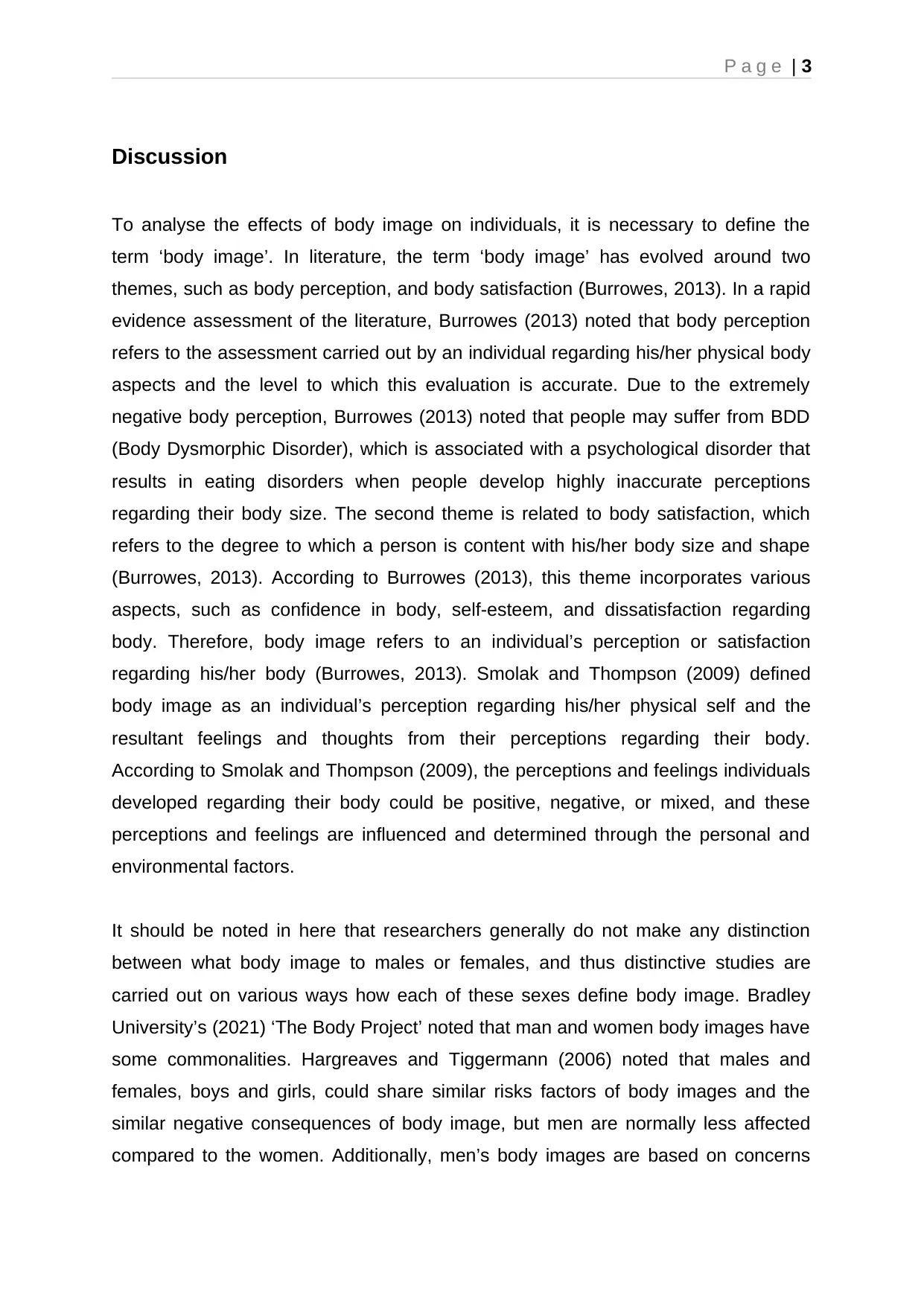
P a g e | 3
Discussion
To analyse the effects of body image on individuals, it is necessary to define the
term ‘body image’. In literature, the term ‘body image’ has evolved around two
themes, such as body perception, and body satisfaction (Burrowes, 2013). In a rapid
evidence assessment of the literature, Burrowes (2013) noted that body perception
refers to the assessment carried out by an individual regarding his/her physical body
aspects and the level to which this evaluation is accurate. Due to the extremely
negative body perception, Burrowes (2013) noted that people may suffer from BDD
(Body Dysmorphic Disorder), which is associated with a psychological disorder that
results in eating disorders when people develop highly inaccurate perceptions
regarding their body size. The second theme is related to body satisfaction, which
refers to the degree to which a person is content with his/her body size and shape
(Burrowes, 2013). According to Burrowes (2013), this theme incorporates various
aspects, such as confidence in body, self-esteem, and dissatisfaction regarding
body. Therefore, body image refers to an individual’s perception or satisfaction
regarding his/her body (Burrowes, 2013). Smolak and Thompson (2009) defined
body image as an individual’s perception regarding his/her physical self and the
resultant feelings and thoughts from their perceptions regarding their body.
According to Smolak and Thompson (2009), the perceptions and feelings individuals
developed regarding their body could be positive, negative, or mixed, and these
perceptions and feelings are influenced and determined through the personal and
environmental factors.
It should be noted in here that researchers generally do not make any distinction
between what body image to males or females, and thus distinctive studies are
carried out on various ways how each of these sexes define body image. Bradley
University’s (2021) ‘The Body Project’ noted that man and women body images have
some commonalities. Hargreaves and Tiggermann (2006) noted that males and
females, boys and girls, could share similar risks factors of body images and the
similar negative consequences of body image, but men are normally less affected
compared to the women. Additionally, men’s body images are based on concerns
Discussion
To analyse the effects of body image on individuals, it is necessary to define the
term ‘body image’. In literature, the term ‘body image’ has evolved around two
themes, such as body perception, and body satisfaction (Burrowes, 2013). In a rapid
evidence assessment of the literature, Burrowes (2013) noted that body perception
refers to the assessment carried out by an individual regarding his/her physical body
aspects and the level to which this evaluation is accurate. Due to the extremely
negative body perception, Burrowes (2013) noted that people may suffer from BDD
(Body Dysmorphic Disorder), which is associated with a psychological disorder that
results in eating disorders when people develop highly inaccurate perceptions
regarding their body size. The second theme is related to body satisfaction, which
refers to the degree to which a person is content with his/her body size and shape
(Burrowes, 2013). According to Burrowes (2013), this theme incorporates various
aspects, such as confidence in body, self-esteem, and dissatisfaction regarding
body. Therefore, body image refers to an individual’s perception or satisfaction
regarding his/her body (Burrowes, 2013). Smolak and Thompson (2009) defined
body image as an individual’s perception regarding his/her physical self and the
resultant feelings and thoughts from their perceptions regarding their body.
According to Smolak and Thompson (2009), the perceptions and feelings individuals
developed regarding their body could be positive, negative, or mixed, and these
perceptions and feelings are influenced and determined through the personal and
environmental factors.
It should be noted in here that researchers generally do not make any distinction
between what body image to males or females, and thus distinctive studies are
carried out on various ways how each of these sexes define body image. Bradley
University’s (2021) ‘The Body Project’ noted that man and women body images have
some commonalities. Hargreaves and Tiggermann (2006) noted that males and
females, boys and girls, could share similar risks factors of body images and the
similar negative consequences of body image, but men are normally less affected
compared to the women. Additionally, men’s body images are based on concerns
⊘ This is a preview!⊘
Do you want full access?
Subscribe today to unlock all pages.

Trusted by 1+ million students worldwide
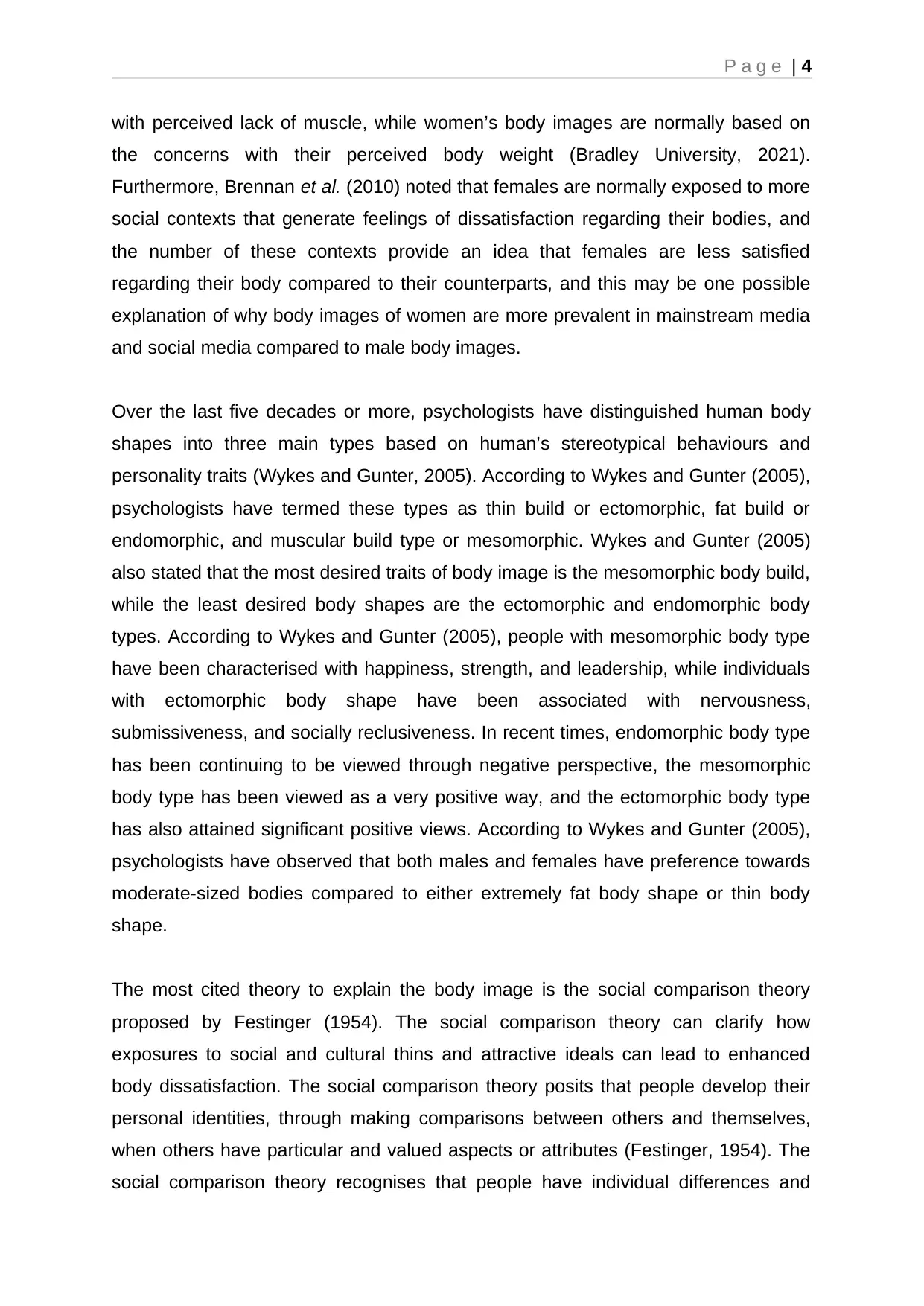
P a g e | 4
with perceived lack of muscle, while women’s body images are normally based on
the concerns with their perceived body weight (Bradley University, 2021).
Furthermore, Brennan et al. (2010) noted that females are normally exposed to more
social contexts that generate feelings of dissatisfaction regarding their bodies, and
the number of these contexts provide an idea that females are less satisfied
regarding their body compared to their counterparts, and this may be one possible
explanation of why body images of women are more prevalent in mainstream media
and social media compared to male body images.
Over the last five decades or more, psychologists have distinguished human body
shapes into three main types based on human’s stereotypical behaviours and
personality traits (Wykes and Gunter, 2005). According to Wykes and Gunter (2005),
psychologists have termed these types as thin build or ectomorphic, fat build or
endomorphic, and muscular build type or mesomorphic. Wykes and Gunter (2005)
also stated that the most desired traits of body image is the mesomorphic body build,
while the least desired body shapes are the ectomorphic and endomorphic body
types. According to Wykes and Gunter (2005), people with mesomorphic body type
have been characterised with happiness, strength, and leadership, while individuals
with ectomorphic body shape have been associated with nervousness,
submissiveness, and socially reclusiveness. In recent times, endomorphic body type
has been continuing to be viewed through negative perspective, the mesomorphic
body type has been viewed as a very positive way, and the ectomorphic body type
has also attained significant positive views. According to Wykes and Gunter (2005),
psychologists have observed that both males and females have preference towards
moderate-sized bodies compared to either extremely fat body shape or thin body
shape.
The most cited theory to explain the body image is the social comparison theory
proposed by Festinger (1954). The social comparison theory can clarify how
exposures to social and cultural thins and attractive ideals can lead to enhanced
body dissatisfaction. The social comparison theory posits that people develop their
personal identities, through making comparisons between others and themselves,
when others have particular and valued aspects or attributes (Festinger, 1954). The
social comparison theory recognises that people have individual differences and
with perceived lack of muscle, while women’s body images are normally based on
the concerns with their perceived body weight (Bradley University, 2021).
Furthermore, Brennan et al. (2010) noted that females are normally exposed to more
social contexts that generate feelings of dissatisfaction regarding their bodies, and
the number of these contexts provide an idea that females are less satisfied
regarding their body compared to their counterparts, and this may be one possible
explanation of why body images of women are more prevalent in mainstream media
and social media compared to male body images.
Over the last five decades or more, psychologists have distinguished human body
shapes into three main types based on human’s stereotypical behaviours and
personality traits (Wykes and Gunter, 2005). According to Wykes and Gunter (2005),
psychologists have termed these types as thin build or ectomorphic, fat build or
endomorphic, and muscular build type or mesomorphic. Wykes and Gunter (2005)
also stated that the most desired traits of body image is the mesomorphic body build,
while the least desired body shapes are the ectomorphic and endomorphic body
types. According to Wykes and Gunter (2005), people with mesomorphic body type
have been characterised with happiness, strength, and leadership, while individuals
with ectomorphic body shape have been associated with nervousness,
submissiveness, and socially reclusiveness. In recent times, endomorphic body type
has been continuing to be viewed through negative perspective, the mesomorphic
body type has been viewed as a very positive way, and the ectomorphic body type
has also attained significant positive views. According to Wykes and Gunter (2005),
psychologists have observed that both males and females have preference towards
moderate-sized bodies compared to either extremely fat body shape or thin body
shape.
The most cited theory to explain the body image is the social comparison theory
proposed by Festinger (1954). The social comparison theory can clarify how
exposures to social and cultural thins and attractive ideals can lead to enhanced
body dissatisfaction. The social comparison theory posits that people develop their
personal identities, through making comparisons between others and themselves,
when others have particular and valued aspects or attributes (Festinger, 1954). The
social comparison theory recognises that people have individual differences and
Paraphrase This Document
Need a fresh take? Get an instant paraphrase of this document with our AI Paraphraser
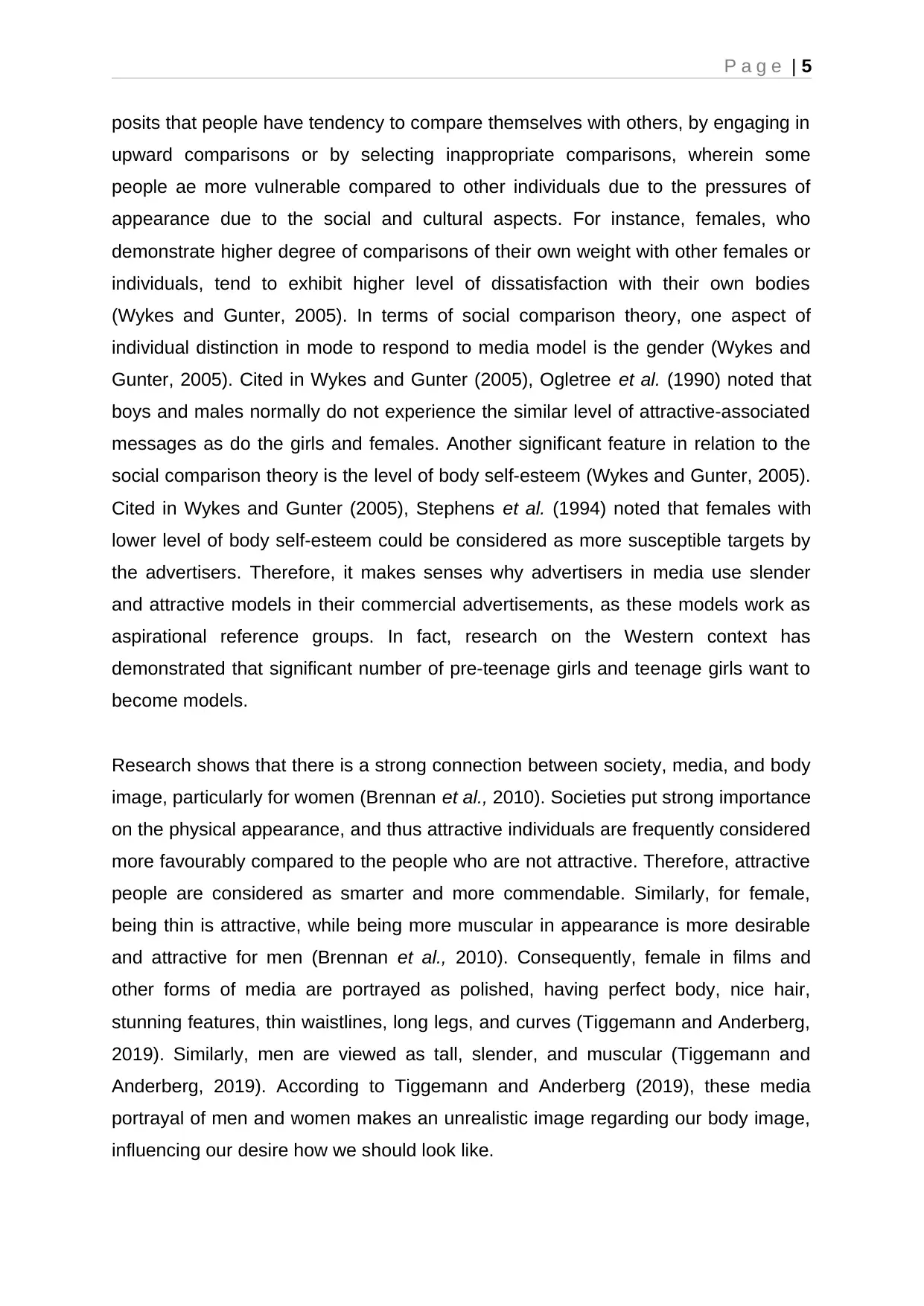
P a g e | 5
posits that people have tendency to compare themselves with others, by engaging in
upward comparisons or by selecting inappropriate comparisons, wherein some
people ae more vulnerable compared to other individuals due to the pressures of
appearance due to the social and cultural aspects. For instance, females, who
demonstrate higher degree of comparisons of their own weight with other females or
individuals, tend to exhibit higher level of dissatisfaction with their own bodies
(Wykes and Gunter, 2005). In terms of social comparison theory, one aspect of
individual distinction in mode to respond to media model is the gender (Wykes and
Gunter, 2005). Cited in Wykes and Gunter (2005), Ogletree et al. (1990) noted that
boys and males normally do not experience the similar level of attractive-associated
messages as do the girls and females. Another significant feature in relation to the
social comparison theory is the level of body self-esteem (Wykes and Gunter, 2005).
Cited in Wykes and Gunter (2005), Stephens et al. (1994) noted that females with
lower level of body self-esteem could be considered as more susceptible targets by
the advertisers. Therefore, it makes senses why advertisers in media use slender
and attractive models in their commercial advertisements, as these models work as
aspirational reference groups. In fact, research on the Western context has
demonstrated that significant number of pre-teenage girls and teenage girls want to
become models.
Research shows that there is a strong connection between society, media, and body
image, particularly for women (Brennan et al., 2010). Societies put strong importance
on the physical appearance, and thus attractive individuals are frequently considered
more favourably compared to the people who are not attractive. Therefore, attractive
people are considered as smarter and more commendable. Similarly, for female,
being thin is attractive, while being more muscular in appearance is more desirable
and attractive for men (Brennan et al., 2010). Consequently, female in films and
other forms of media are portrayed as polished, having perfect body, nice hair,
stunning features, thin waistlines, long legs, and curves (Tiggemann and Anderberg,
2019). Similarly, men are viewed as tall, slender, and muscular (Tiggemann and
Anderberg, 2019). According to Tiggemann and Anderberg (2019), these media
portrayal of men and women makes an unrealistic image regarding our body image,
influencing our desire how we should look like.
posits that people have tendency to compare themselves with others, by engaging in
upward comparisons or by selecting inappropriate comparisons, wherein some
people ae more vulnerable compared to other individuals due to the pressures of
appearance due to the social and cultural aspects. For instance, females, who
demonstrate higher degree of comparisons of their own weight with other females or
individuals, tend to exhibit higher level of dissatisfaction with their own bodies
(Wykes and Gunter, 2005). In terms of social comparison theory, one aspect of
individual distinction in mode to respond to media model is the gender (Wykes and
Gunter, 2005). Cited in Wykes and Gunter (2005), Ogletree et al. (1990) noted that
boys and males normally do not experience the similar level of attractive-associated
messages as do the girls and females. Another significant feature in relation to the
social comparison theory is the level of body self-esteem (Wykes and Gunter, 2005).
Cited in Wykes and Gunter (2005), Stephens et al. (1994) noted that females with
lower level of body self-esteem could be considered as more susceptible targets by
the advertisers. Therefore, it makes senses why advertisers in media use slender
and attractive models in their commercial advertisements, as these models work as
aspirational reference groups. In fact, research on the Western context has
demonstrated that significant number of pre-teenage girls and teenage girls want to
become models.
Research shows that there is a strong connection between society, media, and body
image, particularly for women (Brennan et al., 2010). Societies put strong importance
on the physical appearance, and thus attractive individuals are frequently considered
more favourably compared to the people who are not attractive. Therefore, attractive
people are considered as smarter and more commendable. Similarly, for female,
being thin is attractive, while being more muscular in appearance is more desirable
and attractive for men (Brennan et al., 2010). Consequently, female in films and
other forms of media are portrayed as polished, having perfect body, nice hair,
stunning features, thin waistlines, long legs, and curves (Tiggemann and Anderberg,
2019). Similarly, men are viewed as tall, slender, and muscular (Tiggemann and
Anderberg, 2019). According to Tiggemann and Anderberg (2019), these media
portrayal of men and women makes an unrealistic image regarding our body image,
influencing our desire how we should look like.
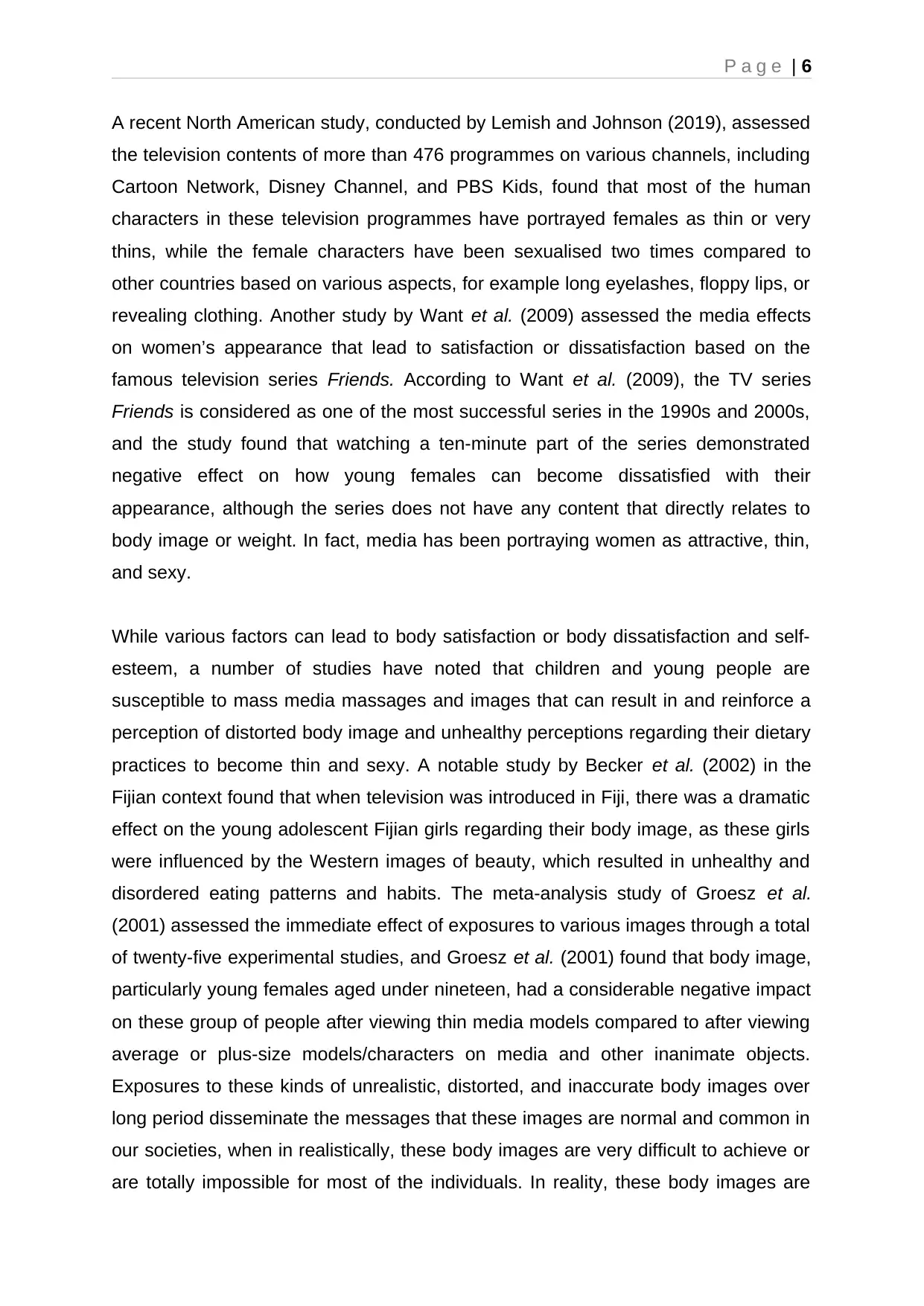
P a g e | 6
A recent North American study, conducted by Lemish and Johnson (2019), assessed
the television contents of more than 476 programmes on various channels, including
Cartoon Network, Disney Channel, and PBS Kids, found that most of the human
characters in these television programmes have portrayed females as thin or very
thins, while the female characters have been sexualised two times compared to
other countries based on various aspects, for example long eyelashes, floppy lips, or
revealing clothing. Another study by Want et al. (2009) assessed the media effects
on women’s appearance that lead to satisfaction or dissatisfaction based on the
famous television series Friends. According to Want et al. (2009), the TV series
Friends is considered as one of the most successful series in the 1990s and 2000s,
and the study found that watching a ten-minute part of the series demonstrated
negative effect on how young females can become dissatisfied with their
appearance, although the series does not have any content that directly relates to
body image or weight. In fact, media has been portraying women as attractive, thin,
and sexy.
While various factors can lead to body satisfaction or body dissatisfaction and self-
esteem, a number of studies have noted that children and young people are
susceptible to mass media massages and images that can result in and reinforce a
perception of distorted body image and unhealthy perceptions regarding their dietary
practices to become thin and sexy. A notable study by Becker et al. (2002) in the
Fijian context found that when television was introduced in Fiji, there was a dramatic
effect on the young adolescent Fijian girls regarding their body image, as these girls
were influenced by the Western images of beauty, which resulted in unhealthy and
disordered eating patterns and habits. The meta-analysis study of Groesz et al.
(2001) assessed the immediate effect of exposures to various images through a total
of twenty-five experimental studies, and Groesz et al. (2001) found that body image,
particularly young females aged under nineteen, had a considerable negative impact
on these group of people after viewing thin media models compared to after viewing
average or plus-size models/characters on media and other inanimate objects.
Exposures to these kinds of unrealistic, distorted, and inaccurate body images over
long period disseminate the messages that these images are normal and common in
our societies, when in realistically, these body images are very difficult to achieve or
are totally impossible for most of the individuals. In reality, these body images are
A recent North American study, conducted by Lemish and Johnson (2019), assessed
the television contents of more than 476 programmes on various channels, including
Cartoon Network, Disney Channel, and PBS Kids, found that most of the human
characters in these television programmes have portrayed females as thin or very
thins, while the female characters have been sexualised two times compared to
other countries based on various aspects, for example long eyelashes, floppy lips, or
revealing clothing. Another study by Want et al. (2009) assessed the media effects
on women’s appearance that lead to satisfaction or dissatisfaction based on the
famous television series Friends. According to Want et al. (2009), the TV series
Friends is considered as one of the most successful series in the 1990s and 2000s,
and the study found that watching a ten-minute part of the series demonstrated
negative effect on how young females can become dissatisfied with their
appearance, although the series does not have any content that directly relates to
body image or weight. In fact, media has been portraying women as attractive, thin,
and sexy.
While various factors can lead to body satisfaction or body dissatisfaction and self-
esteem, a number of studies have noted that children and young people are
susceptible to mass media massages and images that can result in and reinforce a
perception of distorted body image and unhealthy perceptions regarding their dietary
practices to become thin and sexy. A notable study by Becker et al. (2002) in the
Fijian context found that when television was introduced in Fiji, there was a dramatic
effect on the young adolescent Fijian girls regarding their body image, as these girls
were influenced by the Western images of beauty, which resulted in unhealthy and
disordered eating patterns and habits. The meta-analysis study of Groesz et al.
(2001) assessed the immediate effect of exposures to various images through a total
of twenty-five experimental studies, and Groesz et al. (2001) found that body image,
particularly young females aged under nineteen, had a considerable negative impact
on these group of people after viewing thin media models compared to after viewing
average or plus-size models/characters on media and other inanimate objects.
Exposures to these kinds of unrealistic, distorted, and inaccurate body images over
long period disseminate the messages that these images are normal and common in
our societies, when in realistically, these body images are very difficult to achieve or
are totally impossible for most of the individuals. In reality, these body images are
⊘ This is a preview!⊘
Do you want full access?
Subscribe today to unlock all pages.

Trusted by 1+ million students worldwide

P a g e | 7
frequently manipulated through digital technologies, and thus they are modified and
improved for achieving these types of ideal body images, which create gaps between
the real world and what we observe in the media. The effect of this not being look
similar to the media characters can be related to declining self-esteem, body
dissatisfaction, and depression (Pai and Schryver, 2015), as well as eating disorders
(Field et al., 1999). Additionally, exposures to sexualising media can result in self-
objectifications among individuals, which can destroy the self-esteem through
physical appearance (Karsay et al., 2018).
The above discussion suggests that, during the period when our societies are
experiencing higher rates of anxieties, depressions, and suicides, these inaccurate,
unrealistic, and distorted body image through media are definitely making more
vulnerable our young girls and women towards their physical and mental health,
which requires regulation to manage these issues. Thus, the House of Commons
Women and Equalities Committee (2021) has noted that many organisations,
experts, civil society, guardians, children welfare agencies, and academics have
been advocating for higher levels of regulations for media and advertising for the
protection of the vulnerable children, young adults, and general people from the
contents that can damage our body images. In the UK, the Advertising Standards
Authority (ASA) is the independent advertising regulatory body that makes sure that
advertisements in the media adhere to the codes of advertising (House of Commons
Women and Equalities Committee, 2021). The ASA has a sister concern – the
Committee of Advertising Practice (CAP), which writes the advertising codes.
Additionally, the Ofcom, which is an independent regulator that sets out rules and
enforce regulations for the online advertisements, has also responsibility to check
the relevancy and pertinency of the advertisements and to make sure that
advertisements that has distorted body image are not broadcasted on the media.
The UK government is also working to put forward the Online Harms legislation to
control these issues, which can improve the safety of the users of the media (House
of Commons Women and Equalities Committee, 2021).
frequently manipulated through digital technologies, and thus they are modified and
improved for achieving these types of ideal body images, which create gaps between
the real world and what we observe in the media. The effect of this not being look
similar to the media characters can be related to declining self-esteem, body
dissatisfaction, and depression (Pai and Schryver, 2015), as well as eating disorders
(Field et al., 1999). Additionally, exposures to sexualising media can result in self-
objectifications among individuals, which can destroy the self-esteem through
physical appearance (Karsay et al., 2018).
The above discussion suggests that, during the period when our societies are
experiencing higher rates of anxieties, depressions, and suicides, these inaccurate,
unrealistic, and distorted body image through media are definitely making more
vulnerable our young girls and women towards their physical and mental health,
which requires regulation to manage these issues. Thus, the House of Commons
Women and Equalities Committee (2021) has noted that many organisations,
experts, civil society, guardians, children welfare agencies, and academics have
been advocating for higher levels of regulations for media and advertising for the
protection of the vulnerable children, young adults, and general people from the
contents that can damage our body images. In the UK, the Advertising Standards
Authority (ASA) is the independent advertising regulatory body that makes sure that
advertisements in the media adhere to the codes of advertising (House of Commons
Women and Equalities Committee, 2021). The ASA has a sister concern – the
Committee of Advertising Practice (CAP), which writes the advertising codes.
Additionally, the Ofcom, which is an independent regulator that sets out rules and
enforce regulations for the online advertisements, has also responsibility to check
the relevancy and pertinency of the advertisements and to make sure that
advertisements that has distorted body image are not broadcasted on the media.
The UK government is also working to put forward the Online Harms legislation to
control these issues, which can improve the safety of the users of the media (House
of Commons Women and Equalities Committee, 2021).
Paraphrase This Document
Need a fresh take? Get an instant paraphrase of this document with our AI Paraphraser

P a g e | 8
Conclusion
In conclusion, this report has analysed the effects of body image on media. It has
been noted that distorted and unrealistic body image can severely affect young
people, particularly girls and young women. Thus, there is a need for more
regulations on this issue. The advertisers and the media have responsibility in this
regard. The content creators need to make more realistic characters, and they
should not create characters that fixates on weight loss and beauty. The media
should create characters that generate body positivity and acceptance.
Refences
Becker, A. E., Burwell, R. A., Herzog, D. B., Hamburg, P., and Gilman, S. E., (2002),
‘Eating behaviours and attitudes following prolonged exposure to television among
ethnic Fijian adolescent girls’, The British Journal of Psychiatry, Vol. 180, Issue 6,
pp. 509-514, Available Online: https://doi.org/10.1192/bjp.180.6.509
Bradley University, (2021), ‘The Body Project’, Available Online:
https://www.bradley.edu/sites/bodyproject/
Brennan, M. A., Lalonde, C. E., Bain, J. L., and Victoria, J. L., (2010), ‘Body Image
Perceptions: Do Gender Differences Exist?’, Psi Chi Journal of Undergraduate
Conclusion
In conclusion, this report has analysed the effects of body image on media. It has
been noted that distorted and unrealistic body image can severely affect young
people, particularly girls and young women. Thus, there is a need for more
regulations on this issue. The advertisers and the media have responsibility in this
regard. The content creators need to make more realistic characters, and they
should not create characters that fixates on weight loss and beauty. The media
should create characters that generate body positivity and acceptance.
Refences
Becker, A. E., Burwell, R. A., Herzog, D. B., Hamburg, P., and Gilman, S. E., (2002),
‘Eating behaviours and attitudes following prolonged exposure to television among
ethnic Fijian adolescent girls’, The British Journal of Psychiatry, Vol. 180, Issue 6,
pp. 509-514, Available Online: https://doi.org/10.1192/bjp.180.6.509
Bradley University, (2021), ‘The Body Project’, Available Online:
https://www.bradley.edu/sites/bodyproject/
Brennan, M. A., Lalonde, C. E., Bain, J. L., and Victoria, J. L., (2010), ‘Body Image
Perceptions: Do Gender Differences Exist?’, Psi Chi Journal of Undergraduate
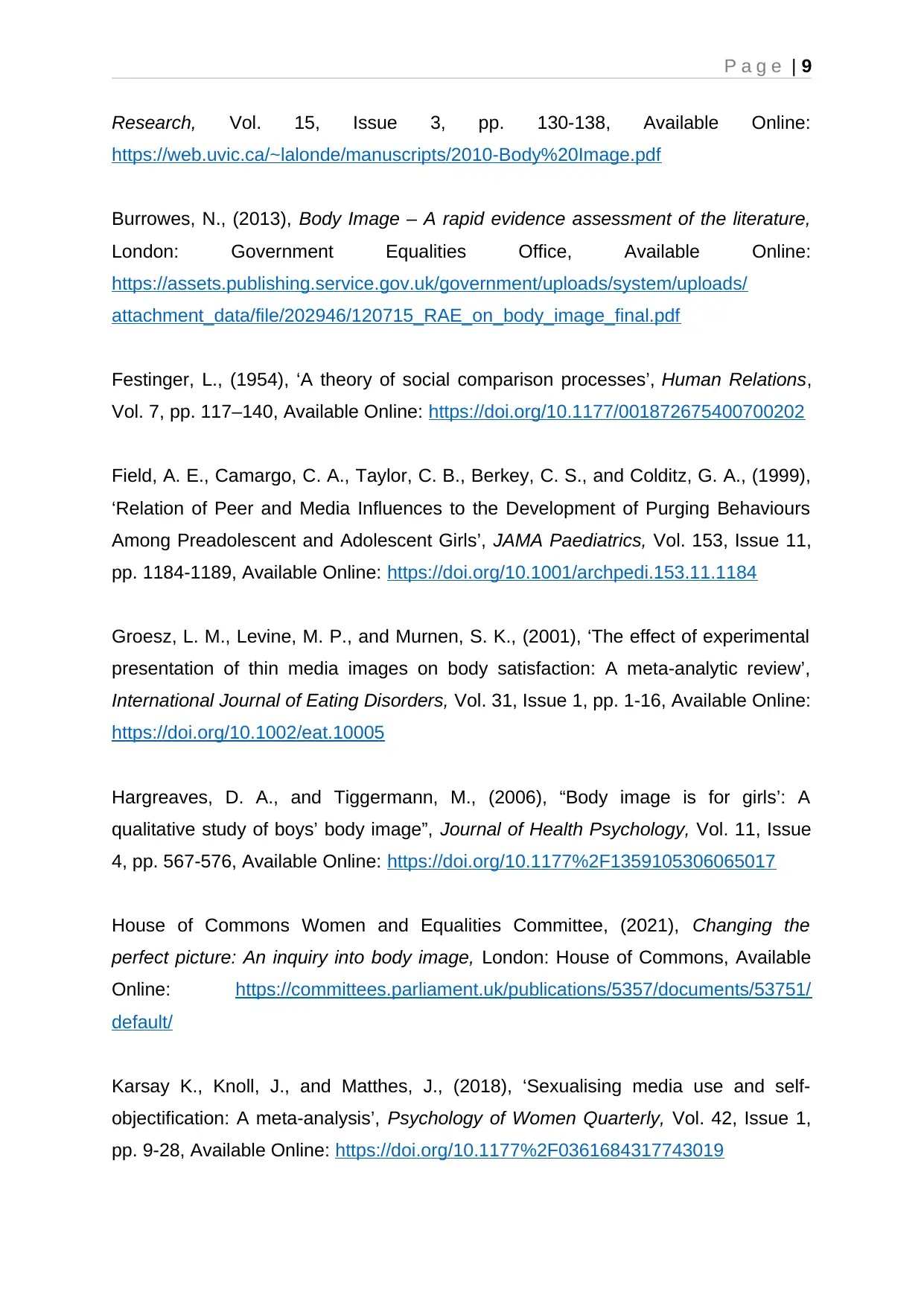
P a g e | 9
Research, Vol. 15, Issue 3, pp. 130-138, Available Online:
https://web.uvic.ca/~lalonde/manuscripts/2010-Body%20Image.pdf
Burrowes, N., (2013), Body Image – A rapid evidence assessment of the literature,
London: Government Equalities Office, Available Online:
https://assets.publishing.service.gov.uk/government/uploads/system/uploads/
attachment_data/file/202946/120715_RAE_on_body_image_final.pdf
Festinger, L., (1954), ‘A theory of social comparison processes’, Human Relations,
Vol. 7, pp. 117–140, Available Online: https://doi.org/10.1177/001872675400700202
Field, A. E., Camargo, C. A., Taylor, C. B., Berkey, C. S., and Colditz, G. A., (1999),
‘Relation of Peer and Media Influences to the Development of Purging Behaviours
Among Preadolescent and Adolescent Girls’, JAMA Paediatrics, Vol. 153, Issue 11,
pp. 1184-1189, Available Online: https://doi.org/10.1001/archpedi.153.11.1184
Groesz, L. M., Levine, M. P., and Murnen, S. K., (2001), ‘The effect of experimental
presentation of thin media images on body satisfaction: A meta-analytic review’,
International Journal of Eating Disorders, Vol. 31, Issue 1, pp. 1-16, Available Online:
https://doi.org/10.1002/eat.10005
Hargreaves, D. A., and Tiggermann, M., (2006), “Body image is for girls’: A
qualitative study of boys’ body image”, Journal of Health Psychology, Vol. 11, Issue
4, pp. 567-576, Available Online: https://doi.org/10.1177%2F1359105306065017
House of Commons Women and Equalities Committee, (2021), Changing the
perfect picture: An inquiry into body image, London: House of Commons, Available
Online: https://committees.parliament.uk/publications/5357/documents/53751/
default/
Karsay K., Knoll, J., and Matthes, J., (2018), ‘Sexualising media use and self-
objectification: A meta-analysis’, Psychology of Women Quarterly, Vol. 42, Issue 1,
pp. 9-28, Available Online: https://doi.org/10.1177%2F0361684317743019
Research, Vol. 15, Issue 3, pp. 130-138, Available Online:
https://web.uvic.ca/~lalonde/manuscripts/2010-Body%20Image.pdf
Burrowes, N., (2013), Body Image – A rapid evidence assessment of the literature,
London: Government Equalities Office, Available Online:
https://assets.publishing.service.gov.uk/government/uploads/system/uploads/
attachment_data/file/202946/120715_RAE_on_body_image_final.pdf
Festinger, L., (1954), ‘A theory of social comparison processes’, Human Relations,
Vol. 7, pp. 117–140, Available Online: https://doi.org/10.1177/001872675400700202
Field, A. E., Camargo, C. A., Taylor, C. B., Berkey, C. S., and Colditz, G. A., (1999),
‘Relation of Peer and Media Influences to the Development of Purging Behaviours
Among Preadolescent and Adolescent Girls’, JAMA Paediatrics, Vol. 153, Issue 11,
pp. 1184-1189, Available Online: https://doi.org/10.1001/archpedi.153.11.1184
Groesz, L. M., Levine, M. P., and Murnen, S. K., (2001), ‘The effect of experimental
presentation of thin media images on body satisfaction: A meta-analytic review’,
International Journal of Eating Disorders, Vol. 31, Issue 1, pp. 1-16, Available Online:
https://doi.org/10.1002/eat.10005
Hargreaves, D. A., and Tiggermann, M., (2006), “Body image is for girls’: A
qualitative study of boys’ body image”, Journal of Health Psychology, Vol. 11, Issue
4, pp. 567-576, Available Online: https://doi.org/10.1177%2F1359105306065017
House of Commons Women and Equalities Committee, (2021), Changing the
perfect picture: An inquiry into body image, London: House of Commons, Available
Online: https://committees.parliament.uk/publications/5357/documents/53751/
default/
Karsay K., Knoll, J., and Matthes, J., (2018), ‘Sexualising media use and self-
objectification: A meta-analysis’, Psychology of Women Quarterly, Vol. 42, Issue 1,
pp. 9-28, Available Online: https://doi.org/10.1177%2F0361684317743019
⊘ This is a preview!⊘
Do you want full access?
Subscribe today to unlock all pages.

Trusted by 1+ million students worldwide
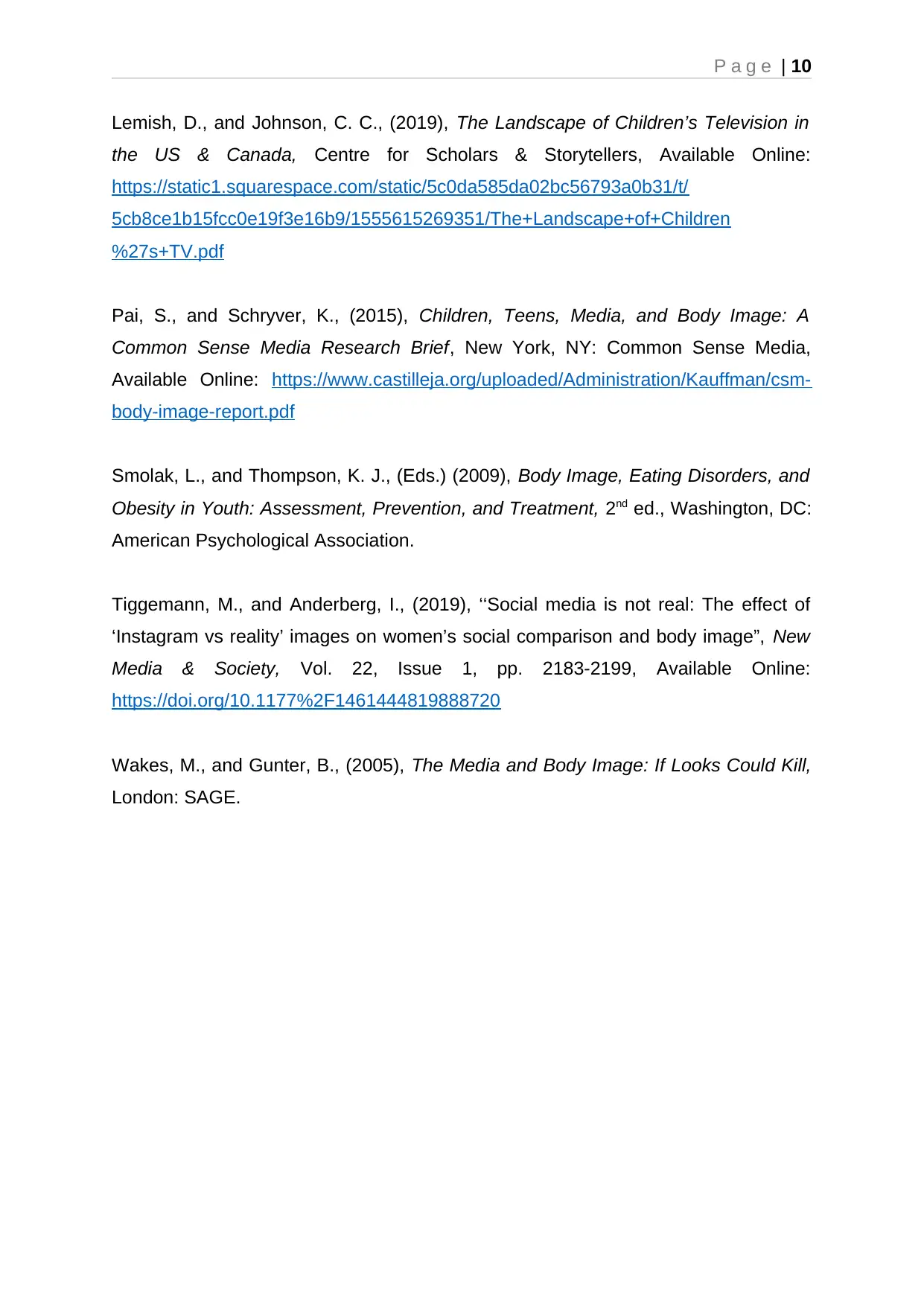
P a g e | 10
Lemish, D., and Johnson, C. C., (2019), The Landscape of Children’s Television in
the US & Canada, Centre for Scholars & Storytellers, Available Online:
https://static1.squarespace.com/static/5c0da585da02bc56793a0b31/t/
5cb8ce1b15fcc0e19f3e16b9/1555615269351/The+Landscape+of+Children
%27s+TV.pdf
Pai, S., and Schryver, K., (2015), Children, Teens, Media, and Body Image: A
Common Sense Media Research Brief, New York, NY: Common Sense Media,
Available Online: https://www.castilleja.org/uploaded/Administration/Kauffman/csm-
body-image-report.pdf
Smolak, L., and Thompson, K. J., (Eds.) (2009), Body Image, Eating Disorders, and
Obesity in Youth: Assessment, Prevention, and Treatment, 2nd ed., Washington, DC:
American Psychological Association.
Tiggemann, M., and Anderberg, I., (2019), ‘‘Social media is not real: The effect of
‘Instagram vs reality’ images on women’s social comparison and body image”, New
Media & Society, Vol. 22, Issue 1, pp. 2183-2199, Available Online:
https://doi.org/10.1177%2F1461444819888720
Wakes, M., and Gunter, B., (2005), The Media and Body Image: If Looks Could Kill,
London: SAGE.
Lemish, D., and Johnson, C. C., (2019), The Landscape of Children’s Television in
the US & Canada, Centre for Scholars & Storytellers, Available Online:
https://static1.squarespace.com/static/5c0da585da02bc56793a0b31/t/
5cb8ce1b15fcc0e19f3e16b9/1555615269351/The+Landscape+of+Children
%27s+TV.pdf
Pai, S., and Schryver, K., (2015), Children, Teens, Media, and Body Image: A
Common Sense Media Research Brief, New York, NY: Common Sense Media,
Available Online: https://www.castilleja.org/uploaded/Administration/Kauffman/csm-
body-image-report.pdf
Smolak, L., and Thompson, K. J., (Eds.) (2009), Body Image, Eating Disorders, and
Obesity in Youth: Assessment, Prevention, and Treatment, 2nd ed., Washington, DC:
American Psychological Association.
Tiggemann, M., and Anderberg, I., (2019), ‘‘Social media is not real: The effect of
‘Instagram vs reality’ images on women’s social comparison and body image”, New
Media & Society, Vol. 22, Issue 1, pp. 2183-2199, Available Online:
https://doi.org/10.1177%2F1461444819888720
Wakes, M., and Gunter, B., (2005), The Media and Body Image: If Looks Could Kill,
London: SAGE.
1 out of 10
Your All-in-One AI-Powered Toolkit for Academic Success.
+13062052269
info@desklib.com
Available 24*7 on WhatsApp / Email
![[object Object]](/_next/static/media/star-bottom.7253800d.svg)
Unlock your academic potential
Copyright © 2020–2025 A2Z Services. All Rights Reserved. Developed and managed by ZUCOL.